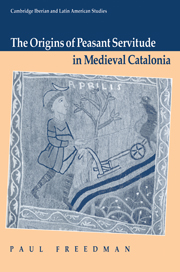Book contents
- Frontmatter
- Contents
- List of tables
- Preface
- List of abbreviations
- Map 1 Densities of Remença households at the end of the Civil War
- Map 2 Catalan comarcas and principal towns
- Map 3 Pyrenees and pre-Pyrenees
- 1 Introduction: medieval serfdom and Catalonia
- 2 Enduring characteristics of rural Catalonia
- 3 The free peasants of the ninth to eleventh centuries
- 4 Changes in the status of peasants: late twelfth and early thirteenth centuries
- 5 Catalan servitude in the thirteenth century
- 6 Effects of the Black Death
- 7 Peasant agitation and civil war, 1388–1486
- Conclusion: origins of Catalan servitude
- Appendix 1
- Appendix 2
- Appendix 3
- Appendix 4
- Bibliography
- Index
7 - Peasant agitation and civil war, 1388–1486
Published online by Cambridge University Press: 06 January 2010
- Frontmatter
- Contents
- List of tables
- Preface
- List of abbreviations
- Map 1 Densities of Remença households at the end of the Civil War
- Map 2 Catalan comarcas and principal towns
- Map 3 Pyrenees and pre-Pyrenees
- 1 Introduction: medieval serfdom and Catalonia
- 2 Enduring characteristics of rural Catalonia
- 3 The free peasants of the ninth to eleventh centuries
- 4 Changes in the status of peasants: late twelfth and early thirteenth centuries
- 5 Catalan servitude in the thirteenth century
- 6 Effects of the Black Death
- 7 Peasant agitation and civil war, 1388–1486
- Conclusion: origins of Catalan servitude
- Appendix 1
- Appendix 2
- Appendix 3
- Appendix 4
- Bibliography
- Index
Summary
The king and the peasants
The first influential movement to demand abolition of the bad customs emerged in the 1380s. In 1388 King John I attempted to abolish servile exactions, citing historical as well as moral justification for putting an end to what he regarded as a long but finite period of servitude. In his brief letter the king seemed to represent a current of opinion condemning the persistence of the evil customs. At this time the outline was traced of what would, a century later, become the formula of a solution: the peasants would compensate the lords to end the degrading aspects of seigneurial control, but the institutions of tenancy and rent would remain intact, shorn of the most immediate impositions of coercive power.
The Catalan peasants in the period before the outbreak of war in 1462 were extraordinarily well-organized and articulate. We know, for example, that a delegation of Remences visited King Alfonso IV in Naples at least once between 1450 and 1455, and that they paid for their own voyage, because as late as 1491 efforts were still being made to obtain compensation from the royal treasury for their travel expenses. Vespasiano da Bisticci records as an instance of Alfonso's courtesy and liberality his rebuke to the Neapolitan courtiers who mocked the rustic Catalan petitioners on this or a similar occasion.
- Type
- Chapter
- Information
- The Origins of Peasant Servitude in Medieval Catalonia , pp. 179 - 202Publisher: Cambridge University PressPrint publication year: 1991

